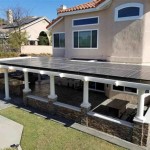How To Build A Brick Patio On Grass
Constructing a brick patio directly on grass presents a cost-effective and aesthetically pleasing approach to enhancing outdoor living spaces. This method, compared to constructing a patio over a concrete base, requires less material and labor, making it an attractive option for many homeowners. However, successful implementation necessitates meticulous planning and execution to ensure stability, drainage, and a level surface resistant to the long-term effects of settling and weed growth. This guide provides a comprehensive overview of the process, outlining the necessary steps for building a durable and visually appealing brick patio directly on grass.
The primary challenge in building a brick patio on grass lies in preventing the underlying soil from shifting, which can cause the bricks to become uneven and create tripping hazards. Therefore, proper excavation, the use of appropriate base materials, and careful installation techniques are crucial. Furthermore, weed control is a significant concern, requiring the implementation of effective barriers to prevent unwanted vegetation from growing between the bricks.
Planning and Preparation
Before commencing any physical labor, a detailed plan is essential. The plan should encompass the desired size and shape of the patio, the type of bricks to be used, and a comprehensive material list. Accurate measurements are paramount, as they will dictate the quantity of materials needed and the overall layout of the patio. It is also prudent to consult local building codes and regulations to ensure compliance with any applicable restrictions regarding patio construction.
Determine the location of the patio, considering factors such as sunlight exposure, proximity to the house, and existing landscaping. Mark the perimeter of the patio with stakes and string. Use a line level to ensure that the string is level, as this will serve as a guide for excavation. If the patio is adjacent to a house, ensure that the finished patio surface is at least 4 inches below the damp-proof course of the house to prevent water ingress.
Next, perform a soil test to determine the soil's composition and drainage characteristics. This information will inform the choice of base materials and the depth of excavation required. In areas with poor drainage, consider installing a drainage system to prevent water from accumulating beneath the patio. This could involve installing a perforated pipe surrounded by gravel, leading to a suitable drainage outlet.
Acquire the necessary tools and materials. Essential tools include a shovel, a wheelbarrow, a tamper, a level (both a spirit level and a long level), a rubber mallet, a measuring tape, a utility knife, a broom, and safety glasses. Materials include bricks, landscape fabric, gravel, sand, and polymeric sand or mortar. Ensure that the quantity of materials procured is sufficient for the size of the patio, with a slight margin for waste.
Excavation and Base Preparation
The excavation process involves removing the grass and topsoil within the marked area to create a stable base for the patio. The depth of excavation will depend on the type of soil and the desired thickness of the base materials. As a general rule, excavate to a depth of at least 6 inches, or more if the soil is particularly unstable. Remove all grass, roots, and debris from the excavated area.
After excavation, compact the exposed soil using a tamper. This will help to create a firm and level base. Next, lay down a layer of landscape fabric over the compacted soil. This fabric serves as a weed barrier, preventing weeds from growing up through the bricks. Overlap the edges of the fabric to ensure complete coverage. Secure the fabric with landscape staples to prevent it from shifting during subsequent steps.
Spread a layer of gravel over the landscape fabric. The gravel should be approximately 4 inches thick and should consist of crushed stone or similar material. The gravel provides drainage and helps to distribute the weight of the patio evenly. Use a shovel and rake to spread the gravel evenly, and then compact it thoroughly with a tamper. Verify the level of the gravel base using a long level, making adjustments as necessary to ensure a flat and even surface.
Following the gravel layer, add a layer of sand. This sand layer acts as a bedding material for the bricks, allowing for fine adjustments and ensuring a smooth and level surface. The sand layer should be approximately 1 inch thick. Use a screed board to level the sand, creating a smooth and even surface. Compact the sand lightly with a tamper or a hand roller to prevent excessive settling later on.
Brick Installation and Joint Filling
With the base properly prepared, the brick installation process can commence. Begin laying the bricks according to the chosen pattern. Common patterns include running bond, herringbone, and basket weave. Start in one corner of the patio and work outwards, maintaining consistent spacing between the bricks. Use spacers or a string line to ensure uniform spacing.
Press each brick firmly into the sand, ensuring that it is level with the surrounding bricks. Use a rubber mallet to gently tap the bricks into place. Check the level frequently using a spirit level and make adjustments as needed. If a brick is too high, remove it and add more sand. If a brick is too low, remove it and remove some sand. Continue laying the bricks until the entire patio surface is covered.
After the bricks are laid, cut any bricks that are necessary to fit the perimeter of the patio. Use a brick saw or a chisel and hammer to cut the bricks cleanly and accurately. Wear safety glasses during this process to protect your eyes from debris. Install the cut bricks along the edges of the patio, ensuring that they are flush with the surrounding bricks.
Once all the bricks are in place, fill the joints between the bricks with either polymeric sand or mortar. Polymeric sand is a fine sand that contains polymers that bind together when wetted, creating a firm and stable joint that helps to prevent weed growth. Mortar is a more permanent option that provides a stronger and more durable joint. The choice between polymeric sand and mortar depends on the desired aesthetic and the level of maintenance required.
If using polymeric sand, sweep it into the joints using a broom, ensuring that all the joints are completely filled. Use a blower or a brush to remove any excess sand from the surface of the bricks. Lightly mist the patio with water, following the manufacturer's instructions. The water will activate the polymers in the sand, causing it to bind together. Allow the polymeric sand to cure for the recommended time before using the patio.
If using mortar, mix the mortar according to the manufacturer's instructions. Use a trowel to apply the mortar to the joints between the bricks, ensuring that the joints are completely filled. Smooth the mortar with a pointing tool to create a consistent and professional finish. Remove any excess mortar from the surface of the bricks with a damp sponge. Allow the mortar to cure for the recommended time before using the patio.
Ongoing Maintenance
Maintaining a brick patio built on grass requires regular attention to prevent weed growth and ensure the patio remains level. Periodically inspect the patio for any signs of settling or unevenness. If any bricks are sinking or becoming loose, remove them and add more sand beneath them. Re-compact the sand and re-level the bricks.
Apply a weed killer to the patio periodically to prevent weed growth. Choose a weed killer that is safe for use around brick and follow the manufacturer's instructions carefully. Consider using a pre-emergent herbicide to prevent weeds from germinating in the first place. Remove any weeds that do grow by hand, pulling them out by the roots.
Clean the patio regularly with a broom or a hose to remove dirt and debris. Use a mild detergent and water to clean any stains or spills. Avoid using harsh chemicals or abrasive cleaners, as these can damage the bricks. Consider sealing the patio with a brick sealant to protect it from weathering and staining.
By following these steps, a durable and aesthetically pleasing brick patio can be successfully constructed directly on grass. The careful planning, thorough preparation, and meticulous installation will ensure a long-lasting outdoor space that enhances the value and enjoyment of the property. Regular maintenance will help to preserve the patio's appearance and prevent problems from developing over time, resulting in a beautiful and functional addition to the landscape.

Diy Patio With Grass Between Pavers And A Fire Pit

How To Lay A Brick Patio Ez Hang Door

Diy Patio With Grass Between Pavers And A Fire Pit

How To Install A Brick Paver Patio Hunker

How To Build A Brick Patio

Diy Paver Artificial Turf Patio

Diy Patio With Grass Between Pavers And A Fire Pit Backyard Designs

50 Brick Patio Patterns Designs And Ideas Paver Pavers Backyard Grass

Diy Patio With Grass Between Pavers And A Fire Pit

How To Build A Patio An Easy Do It Yourself Project
Related Posts








